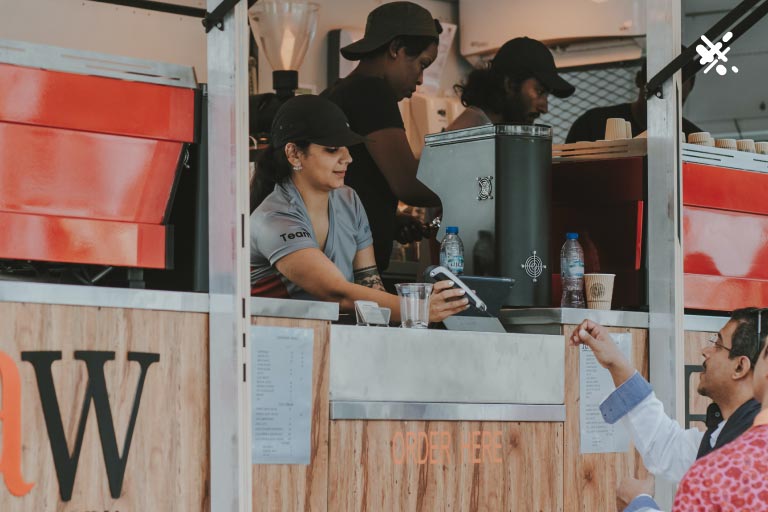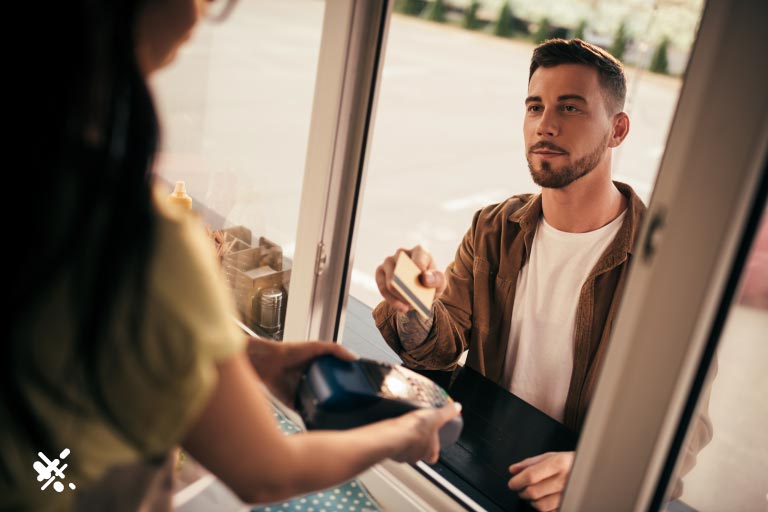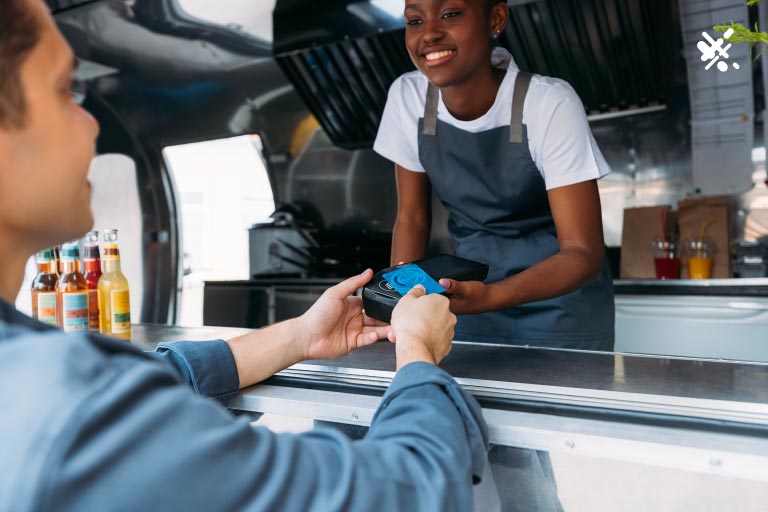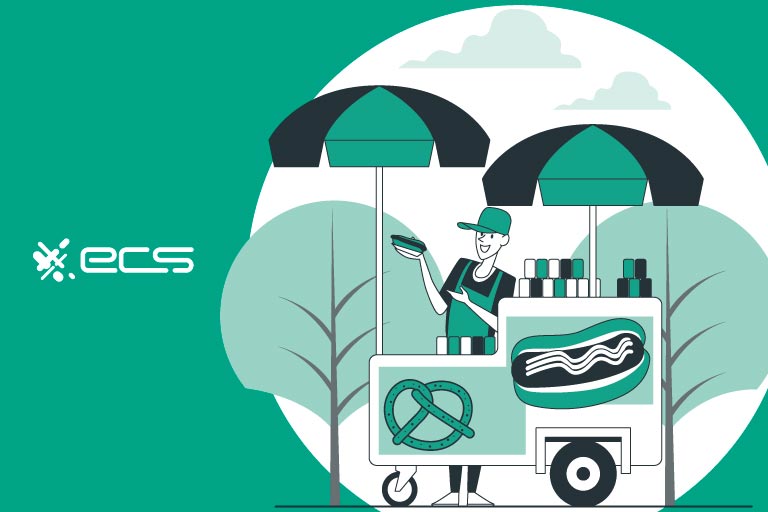Food trucks have become a mainstay in cities around the country. Most areas even have large areas dedicated to food trucks so customers can come and sample a variety of foods and offerings. But a food truck or small food trailer is still a restaurant, which means it needs to consider its payment processing and food truck POS solutions carefully to help maximize revenue.
The right payment solution and POS system for food trucks can provide benefits that help maintain customer loyalty and boost repeat business.
Many food truck owners overlook these advantages when choosing their payment processor, and they end up leaving money on the table. They also end up paying higher fees for what is essentially inferior payment processing that only offers the basics.
In the rest of this article, we’ll go over food truck payment processing in detail. We’ll explain what you should look for in a payment processor and a POS system.
Payment Processing Basics
Whether you run a food truck or a retail business, payment processing performs the same core function. It allows you as the merchant to accept payments such as credit cards, debit cards, or cashless payments such as Apple Pay and others.
Payment processing consists of several components that make up the entire system. It’s essential to understand each of these to understand how the whole system works and how your food truck fits into the picture.
Merchants And Merchant Accounts
As the food truck owner, you are the merchant. You’ll need a merchant account to process credit and debit cards. A merchant account is a particular type of account different from your business bank account.
The merchant account gives you access to the network that processes credit and debit cards. It also holds the funds that are received when payments are authorized. You then move these funds to your bank account.
Payment Processor
The payment processor is who you apply to to receive a merchant account. The payment processor assesses your risk based on your estimated daily or monthly transaction totals. They’ll also look at your average ticket size and other factors. The goal is to offer you the best rates for your type of business and level of risk.
Credit card companies base the risk on the historical data of businesses like yours.
It’s important to note that payment processors for food trucks such as Square are aggregate payment processors. They lump every customer into the same group, and all merchants pay the same flat rate. This often means many food truck owners pay higher fees, especially if they are in a low-risk category.
In these situations, low-risk businesses often subsidize the higher-risk merchants when using Square or other similar services. This is why it’s usually much better and less expensive in the long run to go with an independent payment processor who can offer you an individualized merchant account tailored to your business.
Food trucks generally have lower processing fees than other retailers seeking payment processing. So it’s essential to shop around to find the right mix of value and service for you.
Payment Gateway
The payment gateway is the network that handles the card or mobile payment information through authorization. This means that as the data moves from the merchant to the customer’s issuing bank and back again, it all moves along the payment gateway.
This is important because your point-of-sale software and hardware must be integrated with this payment gateway through the API (application programming interface).
Most of the popular food truck POS software solutions are compatible with the major payment gateways, so this isn’t a big issue for compatibility. However, other software your food truck business may use can also benefit by using a compatible payment gateway.

What You Need For Food Truck Mobile Payment Processing
In addition to the merchant account and payment gateway explained above, you’ll need a mix of hardware and software to handle your mobile payments when running a food truck.
You have a few options ranging from the bare minimum and lowest investment cost to the most fully featured systems. Of course, more features mean a higher initial investment or ongoing monthly fees depending on whether you’re leasing hardware or software.
Basic Hardware For Mobile Payments
Basic hardware will be your most cost-effective solution with the lowest initial investment. It will consist of a mobile payment terminal for mobile credit card processing. You can also use a manual cash drawer for non-electronic payments.
A payment terminal like this is available through your payment processor and can generally either be leased with a per-month charge or bought outright in many cases.
While this setup will work and is inexpensive, it won’t provide any additional functions beyond processing electronic payments.
You’ll also need to connect a receipt printer to the payment terminal. Your Payment processor can also provide these through purchase or lease.
These systems can work via Wi-Fi or 4G, so they can work even if your food truck has no hardwire internet connection or there are otherwise no utilities in the area.
Food Truck POS Systems
The other option for a food truck is to use a point-of-sale system for food trucks. This mix of hardware and software works together to bring additional functionality to your payment processing.
A food truck POS system can still process mobile payments, but the payment processing is integrated into a custom software application run on specific hardware.
This hardware can include a touch screen for food truck staff or even a touch screen for customers to interact with, such as leaving tips or entering information. There is also an integrated printer included to handle receipts.
Since these food truck payment solutions have hardware and software, they are more expensive than using a mobile payment terminal that only processes credit or debit cards.
POS truck systems are sold on a per-month basis, and some have mandatory contracts that can last between 1 and 3 years on average. This is something to be aware of, as getting locked into a long contract with a system that doesn’t work well for you can be a significant drain on your business.
Also, as a new food truck operator, you may get locked into high fees for several years since you didn’t know you could find lower rates by shopping around or choosing the right payment processor. This can really cut into your profits in those early years, which can be most difficult for a food truck business as it tries to pay off loans and other startup costs.
This doesn’t mean that POS systems are not a great option for food trucks. It just means that food truck owners must be careful when selecting since it can be overwhelming at first, and some operators may end up signing a contract that causes problems.
Different Food Truck POS Systems
Many different POS systems are available for food trucks that accept wireless or mobile payments. You’ve likely already seen or heard of solutions like Toast or Touchbistro.
These are popular and are heavily advertised but can have significant drawbacks. These systems also function as your payment processor. If you choose a service such as Toast POS, you must use Toast as your payment processor.
This means the fees you pay are based on what Toast charges, and these are often notoriously high. Also, services like Toast are often not transparent with their fees, and you must get a personal quote by contacting them.
This lack of transparency makes it almost impossible to know if you are paying a high or low rate compared to your competitors or other similar food truck vendors.
Often, the fees and rates by these POS vendors are set to an average that allows them to distribute the risk for all their processing. Unfortunately, this means that the rates and fees are often bad for food trucks at the ends of the spectrum. Small food trucks just starting out and large food trucks with high volumes are penalized the most through this fee structure.

Food Truck POS With Your Own Merchant Account
There are other options where a food truck can have a POS system but not be tied to the integrated payment processor that the POS vendor happens to use.
A perfect example is the Clover system which is available through payment processors like ECS Payments.
Clover is a fully-featured POS that offers mobile payment solutions and advanced features like inventory management and sales data analytics.
The main advantage of this setup is that you apply for and obtain your own merchant account through a payment processor that also offers the Clover POS system.
This means your individual business and history determine your transaction fees. The payment processor can find you the best rates to suit your transaction types and volume. Also, having your own merchant account is far more reliable than using a shared or aggregate merchant account.
Aggregate accounts can be locked or shut down while they investigate any potential issue. This means you may lose access to your funds or cannot process payments in the interrum.
For these reasons, securing your merchant account through a trusted payment processor is always best.
How To Choose The Right Food Truck POS
There are many choices out there now that food trucks have gained such popularity. Many companies have sprung up to provide POS systems. However, they are not all equal.
Here are some critical areas you want to consider when choosing a POS.
Contract Length
Contract Length is very important. It is one of the first things you should consider when deciding on a POS system or a mobile payment solution. Contract terms can range anywhere from month-to-month to years.
For example, Revel Systems offers a restaurant POS system and hardware but requires a 3-year contract. In some cases, this may make for a good deal. However, being locked into an extended contract, especially for a new food truck, may put them in a bad position.
Unless you receive an incredible offer, you’ll generally want to find shorter contract lengths for your hardware and software.
An example is Clover; this has no contracts and is available with month-to-month options.
Add Ons
One of the key advantages of a POS system for mobile payments is the many extra features it can bring to your business. However, some POS vendors charge for these extra features, which makes the price climb over the original quote.
Add-ons are sometimes necessary, and they allow food trucks to customize their payment solution. But basic features should not be tied to additional costs and should be included in the base price.
For example, these features should be in the base POS software at a minimum
- Menu Item customization
- Inventory tracking
- Sales analytics
- Employee performance
- Full payment options, including touchless and online ordering
Hardware That Fits Your Business
A lot of food truck POS systems are also used for restaurant locations. This means their hardware may not always fit a food truck best. Part of this is due to the size. Some of the large POS hardware systems include a large screen which may be too much for a small food truck.
Other systems have two screens: a customer-facing display and one for the employees. Once again, depending on your food truck, this may not be an ideal setup. A customer-facing screen may be too difficult to manage in certain high-traffic or urban areas.
You may also want a standalone card reader so that it is easier to move in and out of the food truck window when serving customers or closing for the day.
It would be best to consider all of these things so you don’t end up with a system that is too large or doesn’t do what you need.
Offline Payments
Most of these mobile payment solutions will use 4G or Wi-Fi to make their connections and perform authorization. But as we all know, cell connections or Wi-Fi can go down for various reasons or be interrupted.
Your mobile payment solution should be able to still process in these situations and then wait to make the final authorization once its internet connection is re-established.
This is especially true if you don’t control or maintain the connection you are using. For example, some food truck pods have a shared Wi-Fi service that the food trucks all pay for and connect to. While these are relatively reliable, you don’t control them; they may go down occasionally.
Without a backup method when this happens, you may not be able to process any electronic orders and will have to switch to cash only, which can really limit your sales, even if only for a brief period.
Menu Management Tools
A food truck often has a changing menu and may have different prices for different times of day or days of the week.
To accommodate this, you’ll want to ensure the POS system you choose has advanced menu management tools so you can easily switch between menus whenever necessary.
Once you switch menus, the screen’s prices and menu buttons will change accordingly, so your staff or employees don’t have to worry about remembering the different prices.
These tools are also great for when you want to run specials or promotions. You can save these in advance. So when it’s needed, you can switch them on to help push certain items.
This tool is also great if you run several trucks. With a POS system, you can simultaneously send all your menu updates to your different locations. So if you change your menu or prices, it’s easy to update all your prices across your entire fleet of trucks if they run the same POS system.
Inventory Control
Inventory control in a food truck is far more critical than in a restaurant. Due to the confined space, you can’t afford to store extra inventory. There is also limited refrigeration and freezer space, which makes inventory selection and management key.
A good food truck POS system will allow you to track inventory based on sold menu items. Each time an item sells, the inventory management system tracks the ingredients related to that item. You can even set up alerts when supplies are running low so you can make adjustments.
As a result, you can better predict what you’ll need to optimize your storage space within the truck, depending on which items are selling.
Loyalty Or Reward Program Options
Some POS systems have a built-in loyalty program or the ability to create your own within the system. Some offer this as an add-on for an additional cost. Most POS systems will allow you to integrate a third-party service that offers loyalty programs or gift cards for food trucks and restaurants.
Depending on your business, you may want to have the option to create a loyalty or reward program. These programs help to increase repeat business and average order size, and they take minimal effort when integrated with a POS system and your mobile payment solution.
Real-time Analytics
If you’re paying for a POS system for mobile payments, it should have real-time analytics that you can view within the POS software or export the data in your formats. So this means either being able to export it as a spreadsheet, data file, or for popular accounting programs.
Ensure the POS includes these tools, not part of an expensive add-on.
VPOS or Virtual Point Of Sale Option For Food Trucks
If you don’t want a full POS system because of budget constraints or want a simpler solution, you can use a VPOS or virtual point-of-sale terminal through your payment gateway for mobile processing.
You’ll need to have your own merchant account through a company like ECS Payments to use this option.
With your merchant account, you will get access to the payment gateway of your choice. Many gateways, such as Authorize.net, offer a VPOS, which you can use to process mobile payments for a food truck. This is known as an mPOS solution or mobile point-of-sale solution.
mPOS and VPOS are value-added services that come with your Authorize.net access. So you don’t need any extra hardware or software. You can use your existing smartphone or tablet or buy inexpensive wireless devices if you don’t have them already. However, these do not have to be specialized.
Using a VPOS is a straightforward process and only requires a few steps to start processing mobile payments.
Step 1: Install the VPOS app
This is a browser-based mobile payment app that you can easily install. It also has a simple interface, so learning to process credits, returns, or voids is easy and intuitive.
Step 2: Use A Compatible Mobile Credit Card Reader
You can use almost any card reader for this situation, and it will connect via a USB cable or Bluetooth. Your payment processor will have different card reader options for you to choose from.
Step 3: Connect A Printer
You can use any printer, although we recommend a compact thermal printer for space savings within a food cart. It’s also faster and helps you move the checkout process along. However, you can generally use any printer you like or already have.
From that point, you are ready to start processing mobile payments for your food truck. This method doesn’t have the built-in tools that many full POS systems have. However, it is also less expensive, with no ongoing costs other than normal processing fees.
You can still perform those additional functions, but you’ll have to manually move data between your payment gateway and your accounting software or spreadsheet program.
If you need help with a solution like this for mobile payments, contact ECS Payments. We can find the perfect solution for your mobile payment needs.

Security For Food Truck POS Mobile Payments
When processing mobile payments, it’s important to be aware of security. Every merchant that processes credit cards needs to understand security and take it seriously. Security rules are outlined by PCI Security Standards Council (PCI SSC).
However, there are extra challenges when processing mobile payments. Mobile payments often involve wireless connections, and several systems all have to work together, which can increase security concerns.
Below are some key areas to be aware of to ensure your mobile payments workflow is secure and that you remain in compliance with all the card company regulations regarding security.
Use Advanced Encryption
If connecting your food truck POS or mobile payment solutions via Wi-Fi, use the most advanced encryption.
The best encryption right now is WPA3. To enable this, you must connect to your Wi-Fi hardware and login into the dashboard or control area. Under the security settings, you should be able to adjust the encryption settings.
Older hardware may not have WPA3 available. If this is the case, you can use WPA2-PSK. However, if it doesn’t have WPA2-PSK as an option, your device is outdated, and you should upgrade it for maximum security.
If you use shared Wi-Fi or a service offered by the food truck pod, ensure you are connected via WPA3 or WPA2 at the minimum. You should not use older encryption like TKIP for secure mobile payments or connecting to the internet for authorizations.
Use Original Passwords
All your devices connected to your mobile payment solutions should have unique passwords to access them. Don’t share passwords with different devices or use the same password for all devices and software.
Make sure to change any default passwords that came with your software or hardware, even if it came from a vendor or payment processor. They may not have changed the passwords after installation, so make sure they are unique.
More Information About Food Truck Payment Processing
Whether you’re an established food truck or looking to launch one for the first time, payment processing can be critical to your success.
ECS Payments can help you find the right payment solutions for your food truck business. If you need a fully-featured POS or a basic mobile payment solution, our experts can find the right option to fit your needs.
Contact ECS Payments and learn more about our innovative payment solutions made specifically for food truck owners and small businesses.
